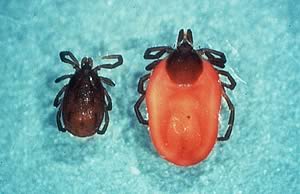| 18/01/07
Sheep producers are being urged to protect their flocks from lice
and tick infestations this lambing season. Lambing time is often
a pretty stressful time, but it can also be a period when lice and
ticks are an added source of irritation for ewes and a health threat
to young lambs, vets warn.
Sheep ticks live away from the host for most of their
life cycle but pose a particular threat to flocks on rough and unimproved
pastures where the natural increase in numbers coincides with the turnout
of ewes and young lambs.
 |
Lice outbreaks, in particular, are on the increase since
the ending of compulsory dipping for sheep scab. “Although
infestations by the biting louse Bovicola ovis do not cause the loss
of body condition associated with sheep scab, they do cause considerable
wool loss and make housed sheep very restless,” explains Schering-Plough
Animal Health livestock veterinary adviser Paul Williams MRCVS.
Infested sheep not only rub, but also bite at their flanks and can
often be seen with wool in their mouths. Unlike sheep scab, patches
of bare skin are uncommon as the wool tends to regrow and there will
also be no sign of scabs on the skin surface. Lice can be spotted
clinging on to the wool of affected sheep – especially if a
sample is held against a dark background – and they are typically
brown in colour with elongated bodies and a definite head.
“Lice infestations can be eliminated by OP dips such as Coopers
Ectoforce,” says Paul Williams. Pour-ons are also effective
against lice, but they do not eliminate them. Pour-ons work best
after shearing, but will also help control infestations in housed
sheep providing they are not carrying excessively heavy fleeces. “Lambs
should be treated at the same time as they can become heavily infested
within weeks of birth,” he adds.
Since lice live permanently on the host animal, transmission is via
infested sheep particularly when they are grouped together for housing
or feeding in winter. “In addition to keeping existing stock
lice free it is very important to isolate, inspect and, if necessary,
treat replacement animals especially rams before they join the main
flock,” Paul Williams advises. This procedure will also help
to avoid the introduction of sheep scab to the flock.
Ticks in contrast, live away from the host for most of their life
cycle but pose a particular threat to flocks on rough and unimproved
pastures where the natural increase in numbers coincides with the
turnout of ewes and young lambs.
As part of its life cycle the sheep tick, Ixodes ricinus, needs a
blood meal from a host animal and the adult females are most likely
to be found attached to the head, legs or other areas of skin not
covered by wool. Their feeding can also cause abscesses in the joints,
spine and internal organs of lambs resulting in a condition known
as tick pyaemia.
“Badly affected lambs frequently die of starvation as they
cannot keep up with the ewes,” Paul Williams says. “Ticks
also transmit louping ill – a viral disease of the nervous
system – and tick-borne fever, an illness characterised by
a sudden high fever for 4-22 days. Abortion can occur in ewes not
previously exposed to infected ticks. Most affected sheep become
carriers and relapses of the disease can occur.”
Fortunately, the advent of effective pour-ons such as the only deltamethrin-based
ectoparasiticide, Coopers Spot On, means heavily pregnant ewes and
lambs can now be treated around lambing with minimal handling. “Adult
and lambs can both be treated at the same time, with lambs able to
be treated within a few days of birth at half the dose rate,” he
advises.
 Farmers to question DEFRA minister over bovine TB fears Farmers to question DEFRA minister over bovine TB fears
 Biosecurity on the Agenda for Agricultural Shows Biosecurity on the Agenda for Agricultural Shows
 Farmers advised on employing foreign workers Farmers advised on employing foreign workers |


